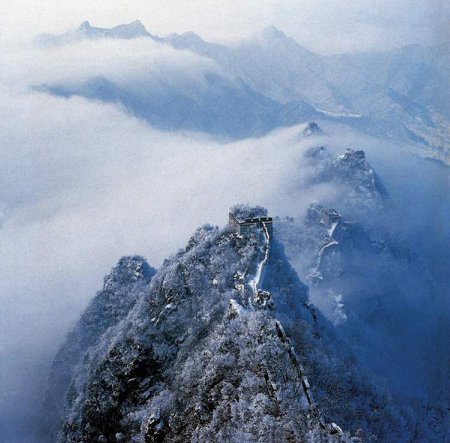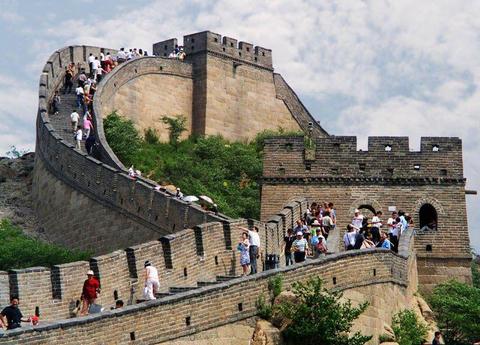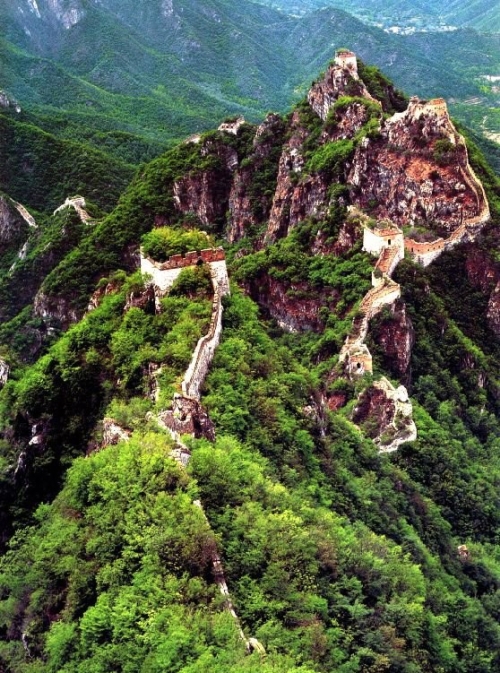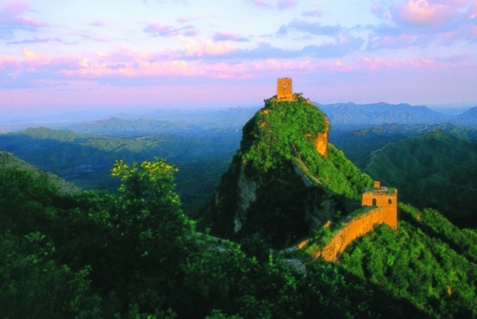
The Great Wall is a protective wall built by the Chinese to guard against invasions from the northern steppe tribes (Mongols, Huns, Manchus, etc.). The Great Wall is the largest structure built by man in terms of length, surface area, and mass. It is one of the most visited tourist sites in the world. It is said to be visible to the naked eye from space, but this claim has been refuted and reaffirmed several times. With a height ranging between six and seven meters and a width of four to five meters, the Great Wall features watchtowers at regular intervals. However, it did not fulfill its protective function as the sentinels were corruptible. On the other hand, it was very useful for transporting goods, people, and materials to remote and sometimes mountainous areas.
Location of the Great Wall
The Great Wall is 6700 km long and stretches from Shanhaiguan, on the edge of the China Sea, to Jiayuguan, in Gansu Province. Visitors thus have a wide choice of visiting points!
History of the Great Wall
During the Warring States period (476-221 BC), the different kingdoms each built walls to protect themselves from invasions, mainly from the northern barbarians. When the First Emperor unified China in 221 BC, he demolished the internal walls of the empire and reconnected the various northern walls. The wall we know dates from the Ming Dynasty (1368-1644), which instituted brick and stone to ensure the longevity of the construction. It eventually fell into oblivion and was saved by tourism. Large parts have been restored and opened to the public.
Visit to the Great Wall
Badaling 八达岭
 This is a place quite close to Beijing, about 70 km to the northwest and at an altitude of 1000 meters. The section was restored in 1957 so that the ramparts and watchtowers are identical to those of the Ming era. The place is easily accessible with a cable car, a museum, a photo gallery, and an impressive panoramic cinema. However, if you like calm, this is not the best place. Nevertheless, the panorama remains wonderful and it is the ideal place to take beautiful photos.
This is a place quite close to Beijing, about 70 km to the northwest and at an altitude of 1000 meters. The section was restored in 1957 so that the ramparts and watchtowers are identical to those of the Ming era. The place is easily accessible with a cable car, a museum, a photo gallery, and an impressive panoramic cinema. However, if you like calm, this is not the best place. Nevertheless, the panorama remains wonderful and it is the ideal place to take beautiful photos.
Most hotels offer tours but beware of prices and make many comparisons to avoid being "ripped off." The most economical way is bus No. 919, which departs from Deshengmen (which can be reached by bus No. 44, departing south of Tian'anmen Square), next to the Jishuitan metro station. The journey takes about 1.5 hours. Departures are every 15 minutes starting from 5:30 AM. On the return trip, the last minibus leaves Badaling at 6:30 PM. Otherwise, large tourist buses depart from the southwest corner of Tian'anmen Square.
Mutianyu 慕田峪

Mutianyu is located 90 km northeast of Beijing. It was a good alternative to Badaling, but this place has become as crowded as the other. The environment is quite wild with steep hills (up to 45° slope!) and forests. The bus does not go all the way to the ramparts and you have to walk a good half hour.
Bus No. 916 departs from Dongzhimen bus station to Huairou, the nearest town (about 1 hour journey). From there, you need to change buses to Mutianyu. Otherwise, there are tourist minibuses that depart from Qianmen, south of Tian'anmen Square. For the return trip, make sure to check the last departure time (5:30 PM?) to avoid getting trapped.
Simatai 司马台
 Simatai is 110 km northeast of the capital. The Great Wall has not been completely restored and visitors can find the more authentic aspect of the Great Wall, such as the "obstacle walls" designed to stop enemies who had already reached the battlements. The place is still very wild. Do not forget to bring water and a picnic. You also need to be a good walker as the place is very steep. You can reach Jinshanling on foot in four hours, but you need to be a good hiker as some passages are very delicate.
Simatai is 110 km northeast of the capital. The Great Wall has not been completely restored and visitors can find the more authentic aspect of the Great Wall, such as the "obstacle walls" designed to stop enemies who had already reached the battlements. The place is still very wild. Do not forget to bring water and a picnic. You also need to be a good walker as the place is very steep. You can reach Jinshanling on foot in four hours, but you need to be a good hiker as some passages are very delicate.
From Dongzhimen bus station, you can take minibuses, but if you are several people, it may be interesting to rent a vehicle or take a taxi.
